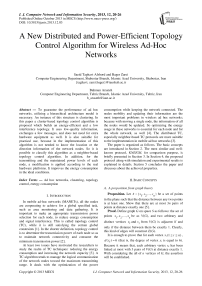A New Distributed and Power-Efficient Topology Control Algorithm for Wireless Ad-Hoc Networks
Автор: Saeid Taghavi Afshord, Bager Zarei, Bahman Arasteh
Журнал: International Journal of Computer Network and Information Security(IJCNIS) @ijcnis
Статья в выпуске: 12 vol.5, 2013 года.
Бесплатный доступ
To guarantee the performance of ad hoc networks, utilizing a hierarchical architecture model is necessary. An instance of this structure is clustering. In this paper a cluster-based topology control algorithm is proposed which builds an energy-efficient and a low interference topology. It uses low-quality information, exchanges a few messages, and does not need for extra hardware equipment as well. It is also suitable for practical use, because in the implementation of this algorithm is not needed to know the location or the direction information of the network nodes. So it is possible to classify this algorithm as a neighbor-based topology control algorithm. In addition, for the transmitting and the maintained power levels of each node, a modification is applied according to the real hardware platforms. It improves the energy consumption in the ideal conditions.
Ad hoc networks, clustering, topology control, energy consumption
Короткий адрес: https://sciup.org/15011251
IDR: 15011251
Список литературы A New Distributed and Power-Efficient Topology Control Algorithm for Wireless Ad-Hoc Networks
- J. Wu, and F. Dai, Mobility-Sensitive Topology Control in Mobile Ad Hoc Networks. IEEE Trans. on Parallel and Distributed Systems, vol 17, (6), 2006, pp. 522-535.
- J. Yu, H. Roh, W. Lee, S. Pack, and D. Du, Topology Control in Cooperative Wireless Ad-Hoc Networks, Selected Areas in Communications, IEEE Journal on, vol. 30, no. 9, pp. 1771-1779, October 2012.
- P. Santi, Topology Control in Wireless Ad Hoc and Sensor Networks, John Wiley & Sons Ltd, England, 2005.
- X. Xie, and H. Zhang, Topology Algorithm Research Based on Energy and Power Control for TopDisc Algorithm. In Proceeding of the 2nd International Conference on Computer Modeling and Simulation, Sanya, China, 2010, pp. 37-40.
- J. A. Bondy, and U. S. R. Murty, Graph theory with applications, Elsevier Science Publishing Co., Inc., 1976.
- J. Y. Yu, and P. H. J. Chong, A Survey of Clustering Schemes for Mobile Ad Hoc Networks. IEEE Communications Surveys and Tutorials, vol 7(1), 2005, pp. 32-48.
- S. Narayanaswamy, V. Kawadia, and et al., Power Control in Ad Hoc Networks: Theory, Architecture, Algorithm and Implementation of the COMPOW Protocol. In Proceeding of the European Wireless Conference, Florence, Italy, 2002, pp. 156–162.
- V. Kawadia, and P. Kumar, Power Control and Clustering in Ad Hoc Networks. In Proceeding of IEEE Infocom, San Francisco, USA, 2003, pp. 459–469.
- D. Blough, M. Leoncini, and et al., The k-Neighbors Protocol for Symmetric Topology Control in Ad Hoc Networks. In Proceeding of ACM MobiHoc, Annapolis, MD., 2003, pp. 41–152.
- A. Savvides, C. Han, and M. Srivastava, Dynamic fine-grained localization in ad hoc networks of sensors. In Proceeding of the ACM Mobicom 01, Rome, Italy, 2001, pp. 166–179.
- L. Girod, and D. Estrin, Robust Range Estimation Using Acoustic and Multimodal Sensing, In Proceeding of the IEEE/RSJ International Conference on Intelligent Robots and Systems (IROS 2001), Maui, Hawaii, USA, pp. 1-9, October 2001.
- M. Chatterjee, K. S. Das, and et al., WCA: A Weighted Clustering Algorithm for Mobile Ad Hoc Networks. Cluster computing Journal, vol 5(2), 2002, pp. 193-204.


